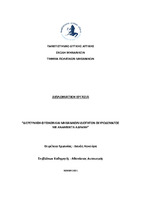| dc.contributor.advisor | Αυτουσμής, Αθανάσιος | |
| dc.contributor.author | Κακούρα, Δανάη | |
| dc.date.accessioned | 2021-07-05T11:14:02Z | |
| dc.date.available | 2021-07-05T11:14:02Z | |
| dc.date.issued | 2021-06 | |
| dc.identifier.uri | https://polynoe.lib.uniwa.gr/xmlui/handle/11400/732 | |
| dc.identifier.uri | http://dx.doi.org/10.26265/polynoe-583 | |
| dc.description.abstract | Με σκοπό την αποτύπωση των φυσικών και μηχανικών ιδιοτήτων του σκυροδέματος, στη σύνθεση του οποίου συμμετέχουν αδρανή υλικά, σε διαφορετικές αναλογίες, επελέγησαν ως αδρανή υλικά ο ασβεστόλιθος, ως συμβατό αδρανές, και ο
ζεόλιθος, ως σύνθετο αδρανές, λόγω των ιδιαίτερων φυσικών ιδιοτήτων του. Μετά από θεωρητική ανασκόπηση των εννοιών του σκυροδέματος, του ασβεστόλιθου και του ζεόλιθου, της Μελέτης Συνθέσεως του σκυροδέματος, όπως αυτή καθορίζεται από τον Κανονισμό Τεχνολογίας Σκυροδέματος, καθώς και τις ιδιότητες του νωπού σκυροδέματος αλλά και της μελέτης της εκτίμησης της αντοχής του με τη χρήση έμμεσων μεθόδων, οδηγούμαστε στο πειραματικό μέρος της παρούσας εργασίας, κατά το οποίο διερευνάται η αντοχή 6+1 δοκιμίων με διαφορετική σύσταση αδρανών. Τα αποτελέσματα της πειραματικής διαδικασίας, συνοπτικά παρουσιαζόμενα, οδήγησαν στο συμπέρασμα ότι σύνθετα αδρανή, όπως στην περίπτωσή μας ο ζεόλιθος, έχουν μεγαλύτερη απαίτηση σε νερό σε σχέση με τα συμβατά αδρανή, όπως στην περίπτωσή μας ο ασβεστόλιθος, συμπέρασμα που επιβεβαιώνεται και με οπτική παρατήρηση κατά την παρασκευή των δοκιμίων και το γεγονός αυτό επηρεάζει δυσμενώς την αντοχή του σκυροδέματος. | el |
| dc.format.extent | 97 | el |
| dc.language.iso | el | el |
| dc.publisher | Πανεπιστήμιο Δυτικής Αττικής | el |
| dc.rights | Αναφορά Δημιουργού - Μη Εμπορική Χρήση - Παρόμοια Διανομή 4.0 Διεθνές | * |
| dc.rights | Attribution-NonCommercial-NoDerivatives 4.0 Διεθνές | * |
| dc.rights.uri | http://creativecommons.org/licenses/by-nc-nd/4.0/ | * |
| dc.subject | Αδρανή υλικά | el |
| dc.subject | Ασβεστόλιθος | el |
| dc.subject | Ζεόλιθος | el |
| dc.subject | Οπλισμένο σκυρόδεμα | el |
| dc.title | Διερεύνηση φυσικών και μηχανικών ιδιοτήτων σκυροδέματος με ανάμεικτα αδρανή | el |
| dc.title.alternative | Investigation of mechanical and physical properties of concrete with mixed aggregates | el |
| dc.type | Διπλωματική εργασία | el |
| dc.contributor.committee | Δενεζάκη, Σταυρούλα | |
| dc.contributor.committee | Kerpelis, Ploutarchos | |
| dc.contributor.faculty | Σχολή Μηχανικών | el |
| dc.contributor.department | Τμήμα Πολιτικών Μηχανικών | el |
| dc.description.abstracttranslated | In order to capture the physical and mechanical properties of the concrete, in which inert materials are composed, in different proportions, limestone, as compatible inert, and zeolite, as composite inert, was chosen as composite inert due to its specific
physical properties. After a theoretical review of the concepts of concrete, limestone and zeolite, the concrete composition study, as defined by the Concrete Technology Regulation, and the properties of the fresh concrete and the study of its resistance assessment using indirect methods, we are led to the experimental part of this paper, in which the strength of 6+1
test pieces with different aggregate composition is being investigated. The results of the experimental procedure, summarized, led to the conclusion that complex aggregates, such as zeolite, have a greater water requirement than compatible aggregates, such as limestone, which was confirmed by visual observation during the process of production of the samples as well and this fact affects the resistance of concrete in a non satisfactory way . | el |


